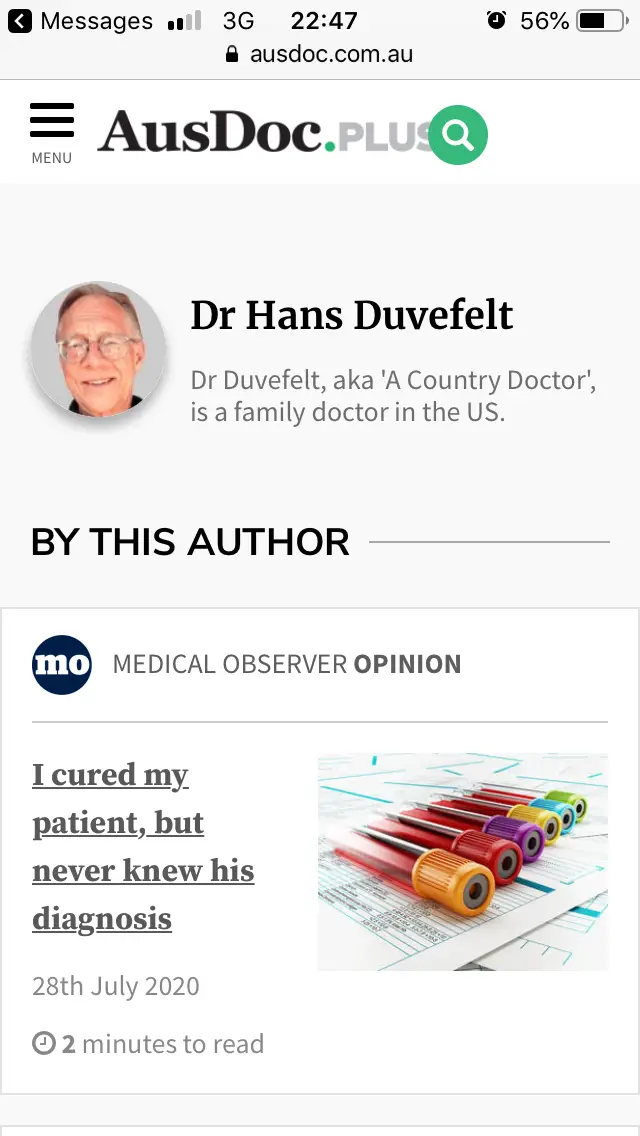
By HANS DUVEFELT

He cancelled his followup appointment because he was feeling fine. He didn’t see the point in wasting a Saturday to come to my clinic when he had lawns to mow and chores to do.
Less than two weeks before that he was sitting on the exam table in my office, again and again nodding off, waking up surprised every time his wife prodded him. The stack of printouts from the emergency room illustrated all the normal testing they had done.
He had experienced a brief episode of numbness in the left side of his face and felt tired with just a slight headache. When I saw him the headache was a bit more severe in the back of his head and down the right side of his neck. But his neck wasn’t stiff.
His blood sugar was 87, normal for most people, but this man had a history of diabetes although his blood sugars had steadily improved over the past year. I told him to stop all his diabetic medications although I don’t think he took notice. His wife said she would make sure he stopped them.
He had had all kinds of bloodwork and both a CT scan and an MRI of his brain. I couldn’t help worrying that he might have an aneurysm so we ordered an MRA as well. Until then my only hope of making him feel better was to make sure he wasn’t in relative hypoglycemia.
A few days later he was back, not the least bit drowsy and with a blood sugar of 138. His MRA was scheduled for the following day.
This time he had swelling, redness and extreme pain around his lower right jaw. It was an oblong, one inch induration (“bump”) and next to it, closer to his neck, there was an area of redness with a few small papules (“pimples”), none of them an actual blister. On his neck there were several small, tender lymph nodes just where I listened to his carotid artery. There was no bruit (“swishing”) to indicate a partial blockage.
The headache on the right side of the back of his head was now severe and he said his right arm hurt and felt heavy, although he didn’t have decreased sensation or strength in it – just pain when he used it.
“The right sided arm pain probably has nothing to do with the left sided facial weakness”, I explained. “The right carotid artery feeds the right side of the brain which controls the left side of the body.”
Testing his sensitivity to light touch, he winced when I touched the lowest portion of his skull and upper neck on the right and also the reddened areas on the right neck and jaw.
I minimized my EMR and pulled up a picture of the nerve supply to the face, neck and arms. I showed them that C2 and C3, the second and third cervical nerves, supply both the back of the head and lower jaw area.
“I see three or four things going on”, I started. “I’m thinking out loud here. You’re not so drowsy and your blood sugar is higher, so that could mean something. The redness and swelling by your jaw could be a bacterial infection. I don’t see where it would come from in your mouth or on your skin, but I want to give you an antibiotic. The pimples we see could be the very beginning of shingles, which can be extremely painful even before the rash and sometimes also without any blisters, so I’m going to give you an antiviral medication. And the pain in the C2-C3 region could either be shingles pain or a pinched nerve in your neck, so I’ll give you some prednisone, which could make you hungry or hyper and raise your blood sugar. Then, tomorrow, call me after the MRA, okay?”
They thanked me and left.
The following day I was busy as usual and never got a call asking for the MRA, but later I saw that the results were normal and that they had made a Saturday followup appointment, so maybe he was feeling better, I presumed.
Then, Saturday, his wife called to cancel and told me how he was feeling completely back to normal without any kind of pain, rash, redness, fatigue or drowsiness, too busy to come in.
I was left wondering exactly what was what, not an unusual situation in primary care. Was there a cellulitis? Did he have shingles with a mild encephalitis? Does he have a disc problem in his neck that might flare up again when he is off the prednisone? And did his blood sugar play any part in his altered mentation? I’ll probably never really know.
I keep coming back to the famous quote by Sir Willam Osler, “Medicine is a science of uncertainty and an art of probability”.
Hans Duvefelt is a Swedish-born rural Family Physician in Maine. This post originally appeared on his blog, A Country Doctor Writes, here.
